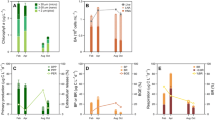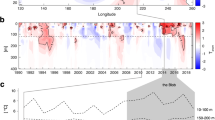Abstract
This study examined possible environmental factors that affect prokaryote variables in surface waters (upper 100 m of water column) in the Canada Basin, western Arctic Ocean. We collected data on prokaryote abundance and heterotrophic production ([3H]leucine incorporation) at eight stations deployed along a slope-to-offshore transect during September 2009. Prokaryote production and growth tended to increase with increasing chlorophyll a (Chl. a) and temperature and with decreasing salinity. The combination of Chl. a, temperature, and salinity accounted for a large fraction (74%) of the variability in prokaryote production, with the highest contribution made by Chl. a (r 2 = 0.56), followed by salinity (r 2 = 0.14) and temperature (r 2 = 0.03). Similarly, the variability in prokaryote growth rate was largely accounted for by the combination of the three environmental variables (overall r 2 of 0.64), with Chl. a making the largest contribution to variability (r 2 = 0.33), followed by salinity (r 2 = 0.27) and temperature (r 2 = 0.05). These data are consistent with the notion that organic matter supply associated with freshwater inputs to surface layers can result in enhanced prokaryote production and growth in the Canada Basin. Our results provide insights into the regulation of the microbial loop in the Canada Basin where freshening has been proceeding rapidly due to increasing river discharge and sea-ice melting.




Similar content being viewed by others
References
Amon RMW, Benner R (1996) Photochemical and microbial consumption of dissolved organic carbon and dissolved oxygen in the Amazon River system. Geochim Cosmochim Acta 60(10):1783–1792
Amon RMW, Meon B (2004) The biogeochemistry of dissolved organic matter and nutrients in two large Arctic estuaries and potential implications for our understanding of the Arctic Ocean system. Mar Chem 92:311–330
Anderson LG (2002) DOC in the Arctic Ocean. In: Hansell DA, Carlson CA (eds) Biogeochemistry of marine dissolved organic matter. Academic, San Diego, pp 665–683
Anderson MJ, Gorley RN, Clarke KR (2008) PERMANOVA+ for PRIMER: guide to software and statistical methods. PRIMER-E, Plymouth
Azam F (1998) Microbial control of oceanic carbon flux: the plot thickens. Science 280(5364):694–696
Benner R (2002) Chemical composition and reactivity. In: Hansell DA, Carlson CA (eds) Biogeochemistry of marine dissolved organic matter. Academic, San Diego, pp 59–90
Borsheim KY (2000) Bacterial production rates and concentrations of organic carbon at the end of the growing season in the Greenland Sea. Aquat Microb Ecol 21(2):115–123
Bussmann I, Kattner G (2000) Distribution of dissolved organic carbon in the central Arctic Ocean: the influence of physical and biological properties. J Mar Syst 27:209–219
Caron DA, Dam HG, Kremer P, Lessard EJ, Madin LP, Malone TC, Napp JM, Peele ER, Roman MR, Youngbluth MJ (1995) The contribution of microorganisms to particulate carbon and nitrogen in surface waters of the Sargasso Sea near Bermuda. Deep Sea Res I 42(6):943–972
Church MJ (2008) Resource control of bacterial dynamics in the sea. In: Kirchman DL (ed) Microbial ecology of the oceans, 2nd edn. Wiley, New Jersey, pp 335–382
Comiso JC, Parkinson CL, Gersten R, Stock L (2008) Accelerated decline in the Arctic sea ice cover. Geophys Res Lett 35:L01703. doi:https://doi.org/10.1029/2007GL031972
Cota GF, Pomeroy LR, Harrison WG, Jones EP, Peters F, Sheldon WM, Weingartner TR (1996) Nutrients, primary production and microbial heterotrophy in the southeastern Chukchi Sea: Arctic summer nutrient depletion and heterotrophy. Mar Ecol Prog Ser 135:247–258
Ducklow H (2000) Bacterial production and biomass in the oceans. In: Kirchman DL (ed) Microbial ecology of the oceans. Wiley, New York, pp 85–120
Garneau ME, Roy S, Lovejoy C, Gratton Y, Vincent WF (2008) Seasonal dynamics of bacterial biomass and production in a coastal arctic ecosystem: Franklin Bay, western Canadian Arctic. J Geophys Res 113:C07S91. doi:https://doi.org/10.1029/2007jc004281
Giannelli V, Thomas DN, Haas C, Kattner G, Kennedy H, Dieckmann GS (2001) Behaviour of dissolved organic matter and inorganic nutrients during experimental sea-ice formation. Ann Glaciol 33:317–321
Kirchman DL (2001) Measuring bacterial biomass production and growth rates from leucine incorporation in natural aquatic environments. In: Paul JH (ed) Methods in microbiology, vol 30. Academic, San Diego, pp 227–237
Kirchman DL, Malmstrom RR, Cottrell MT (2005) Control of bacterial growth by temperature and organic matter in the western Arctic. Deep Sea Res II 5:3386–3395
Kirchman DL, Hill V, Cottrell MT, Gradinger R, Malmstrom RR, Parker A (2009a) Standing stocks, production, and respiration of phytoplankton and heterotrophic bacteria in the western Arctic Ocean. Deep Sea Res II 56(17):1237–1248
Kirchman DL, Moran XAG, Ducklow H (2009b) Microbial growth in the polar oceans—role of temperature and potential impact of climate change. Nat Rev Microbiol 7(6):451–459
Li WKW, McLaughlin FA, Lovejoy C, Carmack EC (2009) Smallest algae thrive as the Arctic Ocean freshens. Science 326(5952):539
Mathis JT, Hansell DA, Bates NR (2005) Strong hydrographic controls on spatial and seasonal variability of dissolved organic carbon in the Chukchi Sea. Deep Sea Res II 52:3245–3258
Meon B, Amon RMW (2004) Heterotrophic bacterial activity and fluxes of dissolved free amino acids and glucose in the Arctic rivers Ob, Yenisei and the adjacent Kara Sea. Aquat Microb Ecol 37(2):121–135
Nagata T (2000) Production mechanisms of dissolved organic matter. In: Kirchman DL (ed) Microbial ecology of the oceans. Wiley, New York, pp 121–152
Nishino S, Shimada K, Itoh M, Yamamoto-Kawai M, Chiba S (2008) East–west differences in water mass, nutrient, and chlorophyll a distributions in the sea ice reduction region of the western Arctic Ocean. J Geophys Res 113:C00A01. doi:https://doi.org/10.1029/2007JC004666
Nishino S, Shimada K, Itoh M, Chiba S (2009) Vertical double silicate maxima in the sea-ice reduction region of the western Arctic Ocean: implications for an enhanced biological pump due to sea-ice reduction. J Oceanogr 65:871–883
Perovich D, Meier W, Maslanik J, Richter-Menge J (2010) Sea ice cover. Arctic Report Card 2010, pp 16–20
Quinn GP, Keough MJ (2002) Experimental design and data analysis for biologists. Cambridge University Press, Cambridge
Rachold V, Eicken H, Gordeev VV, Grigoriev MN, Hubberten HW, Lisitzin AP, Shevchenko VP, Schirrmeister L (2004) Modern terrigenous organic carbon input to the Arctic Ocean. In: Stein R, Macdonald RW (eds) The organic carbon cycles in the Arctic Ocean. Springer, Berlin, pp 33–55
Rich J, Gosselin M, Sherr E, Sherr B, Kirchman DL (1997) High bacterial production, uptake and concentrations of dissolved organic matter in the central Arctic Ocean. Deep Sea Res II 44(8):1645–1663
Sakshaug E (2004) Primary and secondary production in the Arctic. In: Stein R, Macdonald RW (eds) The organic carbon cycles in the Arctic Ocean. Springer, Berlin, pp 58–81
Schlitzer R (2005) Ocean Data View. https://doi.org/odv.awi.de/. Accessed 22 Mar 2011
Sherr BF, Sherr EB (2003) Community respiration/production and bacterial activity in the upper water column of the central Arctic Ocean. Deep Sea Res I 50(4):529–542
Simon M, Azam F (1989) Protein-content and protein-synthesis rates of planktonic marine-bacteria. Mar Ecol Prog Ser 51(3):201–213
Sokal RR, Rohlf FJ (1995) Biometry: the principles and practices of statistics in biological research, 3rd edn. Freeman, New York
Steele M, Ermold W, Zhang JL (2008) Arctic Ocean surface warming trends over the past 100 years. Geophys Res Lett 35(2):L02614. doi:https://doi.org/10.1029/2007gl031651
Steward GF, Smith DC, Azam F (1996) Abundance and production of bacteria and viruses in the Bering and Chukchi Seas. Mar Ecol Prog Ser 131:287–300
Tammert H, Olli K, Sturluson M, Hodal H (2008) Bacterial biomass and activity in the marginal ice zone of the northern Barents Sea. Deep Sea Res II 55:2199–2209
Thomas DN, Lara RJ, Eicken H, Kattner G, Skoog A (1995) Dissolved organic-matter in Arctic multiyear sea-ice during winter—major components and relationship to ice characteristics. Polar Biol 15(7):477–483
Welschmeyer NA (1994) Fluorometric analysis of chlorophyll-a in the presence of chlorophyll-b and pheopigments. Limnol Oceanogr 39(8):1985–1992
Wheeler PA, Gosselin M, Sherr E, Thibault D, Kirchman DL, Benner R, Whitledge TE (1996) Active cycling of organic carbon in the central Arctic Ocean. Nature 380(6576):697–699
Yamamoto-Kawai M, Tanaka N, Pivovarov S (2005). Freshwater and brine behaviors in the Arctic Ocean deduced from historical data of delta O-18 and alkalinity (1929–2002 A.D.). J Geophys Res 110:C10003. doi:https://doi.org/10.1029/2004jc002793
Yamamoto-Kawai M, McLaughlin FA, Carmack EC, Nishino S, Shimada K, Kurita N (2009) Surface freshening of the Canada Basin, 2003–2007: River runoff versus sea ice meltwater. J Geophys Res 114:C00a05. doi:https://doi.org/10.1029/2008jc005000
Yang YH, Motegi C, Yokokawa T, Nagata T (2010) Large-scale distribution patterns of virioplankton in the upper ocean. Aquat Microb Ecol 60(3):233–246
Acknowledgments
We thank the captain, officers, and crew of R/V Mirai and members of Marine Works Japan, Ltd., for their dedicated support during the cruise. We are also grateful for the assistance of all the colleagues who joined the MR09-03 cruise. K. Hamasaki helped coordinate this research and M. Idichi assisted with counting prokaryotes. Y. Yang provided useful information regarding flow cytometric analyses of prokaryotes. This study was financially supported by a Japan Society for the Promotion of Science (JSPS) grant awarded to TN (20310010) and by a Ministry of Education, Culture, Sports, Science and Technology (MEXT) grant awarded to HO (18067007). Financial support was also provided by a Sasakawa Scientific Research Grant awarded to MU.
Author information
Authors and Affiliations
Corresponding author
Rights and permissions
About this article
Cite this article
Uchimiya, M., Fukuda, H., Nishino, S. et al. Does freshening of surface water enhance heterotrophic prokaryote production in the western Arctic? Empirical evidence from the Canada Basin during September 2009. J Oceanogr 67, 589–599 (2011). https://doi.org/10.1007/s10872-011-0059-7
Received:
Revised:
Accepted:
Published:
Issue Date:
DOI: https://doi.org/10.1007/s10872-011-0059-7




